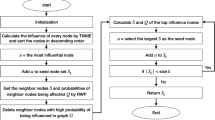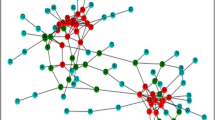Abstract
Influence maximization is the problem of finding a subset of nodes that maximizes the spread of information in a social network. Many solutions have been developed, including greedy and heuristics based algorithms. While the former is very time consuming that might be impractical in many cases, the later is feasible in terms of computational time, but its influence spread is not guaranteed because of limitations in the algorithm. In this study, we propose a new heuristic algorithm which considers the propagation probabilities of nodes in the network individually and takes into account the effect of multi-hop neighbors, thus, it can achieve higher influence spread. A realistic network model with non-uniform propagation probabilities between nodes is assumed in our algorithm. We also examine the optimal number of hops of neighbors to be considered in the algorithm. Experiments using real-world social networks showed that our proposed method outperformed the previous heuristic-based approaches.









Similar content being viewed by others
References
Domingos, P., & Richardson, M. (2001). Mining the network value of customers. In Proceedings of the seventh ACM SIGKDD international conference on Knowledge discovery and data mining (pp. 57–66). ACM.
Richardson, M., & Domingos, P. (2002). Mining knowledge-sharing sites for viral marketing. In Proceedings of the eighth ACM SIGKDD international conference on Knowledge discovery and data mining (pp. 61–70). ACM.
Kempe, D., Kleinberg, J., & Tardos, E. (2003). Maximizing the spread of influence through a social network. In Proceedings of the ninth ACM SIGKDD international conference on Knowledge discovery and data mining (pp. 137–146). ACM.
Leskovec. J., Krause, A., Guestrin, C., Faloutsos, C., VanBriesen, J., & Glance, N. (2007). Cost-effective outbreak detection in networks. In Proceedings of the 13th ACM SIGKDD international conference on Knowledge discovery and data mining (pp. 420–429). ACM.
Goyal, A., Lu, W., & Lakshmanan, L.V. (2011). Celf++: optimizing the greedy algorithm for influence maximization in social networks. In Proceedings of the 20th international conference companion on World wide web (pp. 47–48). ACM.
Chen, W., Wang, Y., & Yang, S. (2009). Efficient influence maximization in social networks. In Proceedings of the 15th ACM SIGKDD international conference on Knowledge discovery and data mining (pp. 199–208). ACM.
Kimura, M., & Saito, K. (2006). Tractable models for information diffusion in social networks. In Knowledge discovery in databases: PKDD 2006 (pp. 259–271). Berlin Heidelberg: Springer.
Kim, H., & Yoneki, E. (2012). Influential neighbours selection for information diffusion in online social networks. The 21st international conference on computer communication networks ICCCN 2012. IEEE (pp. 1–7).
Weskida, M., & Michalski, R. (2016). Evolutionary algorithm for seed selection in social influence process. In IEEE/ACM international conference on advances in social networks analysis and mining (ASONAM) 2016 (pp. 1189–1196).
Granovetter, M. (1978). Threshold models of collective behavior. American Journal of Sociology, 1420–1443.
Watts, D. J. (2002). A simple model of global cascades on random networks. Proceedings of the National Academy of Sciences, 99(9), 5766–5771.
Newman, M. E. (2006). Finding community structure in networks using the eigenvectors of matrices. Physical Review E, 74(3), 036104.
Newman, M. E. (2001). The structure of scientific collaboration networks. Proceedings of the National Academy of Sciences, 98(2), 404–409.
Author information
Authors and Affiliations
Corresponding author
Additional information
This research was supported by the MSIP (Ministry of Science, ICT and Future Planning), Korea, under the ITRC (Information Technology Research Center) support program (IITP-2016-H8501-16-1008) supervised by the IITP (Institute for Information and communications Technology Promotion).
Rights and permissions
About this article
Cite this article
Nguyen, DL., Nguyen, TH., Do, TH. et al. Probability-Based Multi-hop Diffusion Method for Influence Maximization in Social Networks. Wireless Pers Commun 93, 903–916 (2017). https://doi.org/10.1007/s11277-016-3939-8
Published:
Issue Date:
DOI: https://doi.org/10.1007/s11277-016-3939-8




